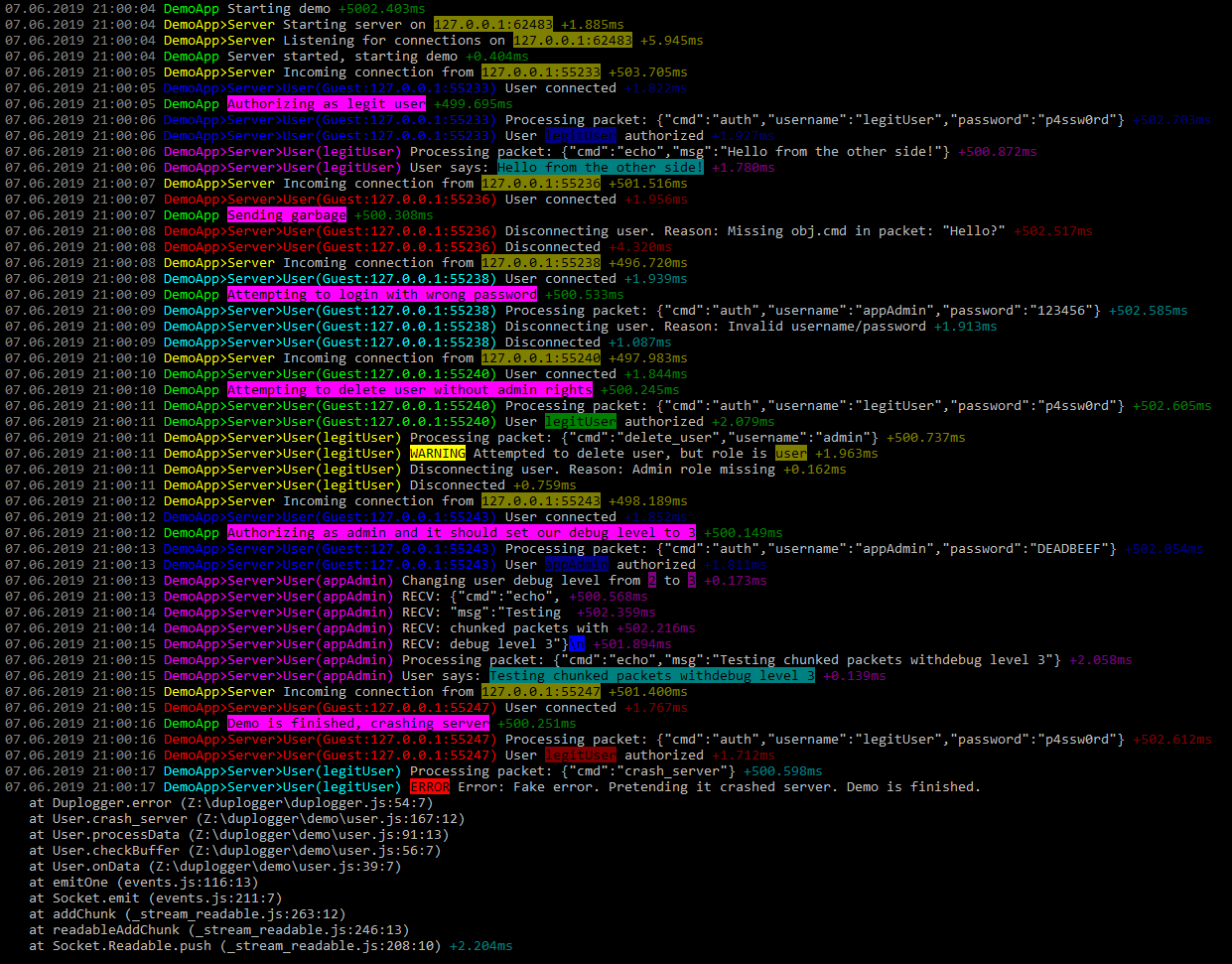duplogger
v1.0.2
Published
Small logger with colors for Node.JS
Readme
Duplogger
A minimalist logger for Node.JS with color schemes.
Execute node ./node_modules/duplogger/test.js to run the demo:

Yet another logger
The search "logger" yields more than 5000 results on NPM so it's likely there are similar modules. It is a set of features I find useful. In order to maintain and deploy the module, I decided to publish it on NPM.
Installation
$ npm install duplogger
How to use
The following approach is my preferred way of calling the API. If you don't like it, you may skip to Configuring.
I don't like loggers with logging levels like:
otherLogger.log(3, 'Dump users: ' + users.dumpUserList()); // 3 is the log levelI find it to be flawed because users.dumpUserList() will execute regardless of the logging level. If the logging level equals or less than 2, the call will simply waste the resources and produce no results.
Instead, I advice to check the logging level beforehand:
if(debug >= 3)
logger.log('Dump users: ' + users.dumpUserList());That way the call users.dumpUserList() will only trigger if the log level equals or higher than 3.
Check test.js for example code.
Also you may want to check the duplogger.js where the source code is located. It's a small file.
Configuring
const Duplogger = require('duplogger');After that you can change some variables. Once you change something it will be used for all instances of logger in all files.
Duplogger.colors- colors that available forlog.colorizeand rotation array. You can delete/add/modify colors. Checkduplogger.jsDuplogger.colors_rotate- array of color names for rotation. Every instance ofDuploggerwill use new color from list.Duplogger.stdout-function(text)- you can create your own function that will receivestdoutso you can save/send it somewhere.Duplogger.stderr- same asDuplogger.stdoutbut forstderrDuplogger.getNewColor(id)- function that rotates color. You can replace it with your own to generate colors based onid. Return color name.Duplogger.in_tty-true/false- enable/disable colors. Check more detailed explanation below.
Duplogger.in_tty
When you require('duplogger') for first time it tries to detect are you running in tty (terminal/console) or you pipe output somewhere using Node.JS's isatty like node app.js > file.log
If duplogger detects that you are not tty then colors will be disabled and all errors will be duplicated to stdout. So running node app.js > file.log will log errors both to strout and stderr.
You can force enable/disable colors using Duplogger.in_tty = true or false;
Duplogger without colors looks like this:

Logger API
After you did const Duplogger = require('duplogger') you can create loggers like let log = new Duplogger(id).id can be any string you want. Like Webserver or User(somename) or what you think is best to debug your app.
log.id-string- id of current logger. You can change it any timelog.color_name-string- name of color thatDuplogger.getNewColorgenerated for us. You can change it any timelog.info(text)- log text tostdoutlog.warn(text)- log text tostderrwith yellow WARNING inverted textlog.error- log errorlog.error(text)- log text tostderrwith red ERROR inverted text and stack tracelog.error(e)- log text tostderrwith red ERROR inverted text and stack trace of e where e is instance of Error
log.colorize- add colors to textlog.colorize(text)- change color of text to curent color of instance ofduploggerlog.colorize(color, text)- change color of text to selected color likered/green/redLight/greenLight. Checkduplogger.jsfor list of colors of add yours modifyingDuplogger.colorslog.colorize(opt, text)- apply object of options to textopt.color- name of color to paint text (by default current color of instance of duplogger)opt.light-true/false- light version of color (work only for dark colors likered,greenbut notredLightorgreenLightsince they already lightedredandgreen)opt.invert-true/false- invert colors around text (create colored box around text)opt.underline-true/false- underline text. (May not work. Depends on fonts that you use in your terminal. I never use it anyway)opt.blink-true/false- blinking text. (May not work. Depends on fonts that you use in your terminal. I never use it anyway)
log.light- change color of text to light version of colorlog.light(text)- alias forlog.colorize({light: true}, text)(Change color of text to light version of current color of current instance ofduplogger)log.light(color, text)- alias forlog.colorize({color: color, light: true}, text)orlog.colorize('colornameLight', text)
log.invert- invert color of text (create colored box around text)log.invert(text)- alias forlog.colorize({invert: true}, text)(Create colored box around text using color of current instance ofduplogger)log.invert(color, text)- alias forlog.colorize({color: color, invert: true}, text)
log.underline- underline text. (May not work. Depends on fonts that you use in your terminal. I never use it anyway)log.underline(text)- alias forlog.colorize({underline: true}, text)log.underline(color, text)- alias forlog.colorize({color: color, underline: true}, text)
log.blink- blinking text. (May not work. Depends on fonts that you use in your terminal. I never use it anyway)log.blink(text)- alias forlog.colorize({blink: true}, text)log.blink(color, text)- alias forlog.colorize({color: color, blink: true}, text)
log.child(id)- creates new instance from current instance. Will add parentid. If we havelog.id = 'Server'thenchild('IncommingConnection')will create new logger withlog.id = 'Server>IncommingConnection'.
Runnode ./node_modules/duplogger/test.jsto see how it works.
Good luck!
And I recommend to look at source code of test.js and duplogger.js to see how I use duplogger and source of it to check color names and other stuff.
